Disclaimer: This post may contain Amazon affiliate links. Sudachi earns a small percentage from qualifying purchases at no extra cost to you. See disclaimer for more info.
What is Tsukimi Dango?
Dango is a traditional Japanese sweet dumpling made with glutinous rice flour. They are well loved for their mildly sweet rice flavor and delightfully chewy texture. Dango play an important part in Japanese culture, historically they were used as offerings and are enjoyed during traditional Japanese holidays, festivals and events to this day.
One variation is the Tsukimi Dango, which is displayed and eaten during the moon viewing festival known in Japanese as “Tsukimi” (月見). The moon viewing festival is a time to show appreciation for the beautiful autumn moon and express gratitude for the year’s harvest. Since dango made from rice, it’s only natural that it became an important symbol of this festival. Not only that, but the round shape also resembles the full moon!
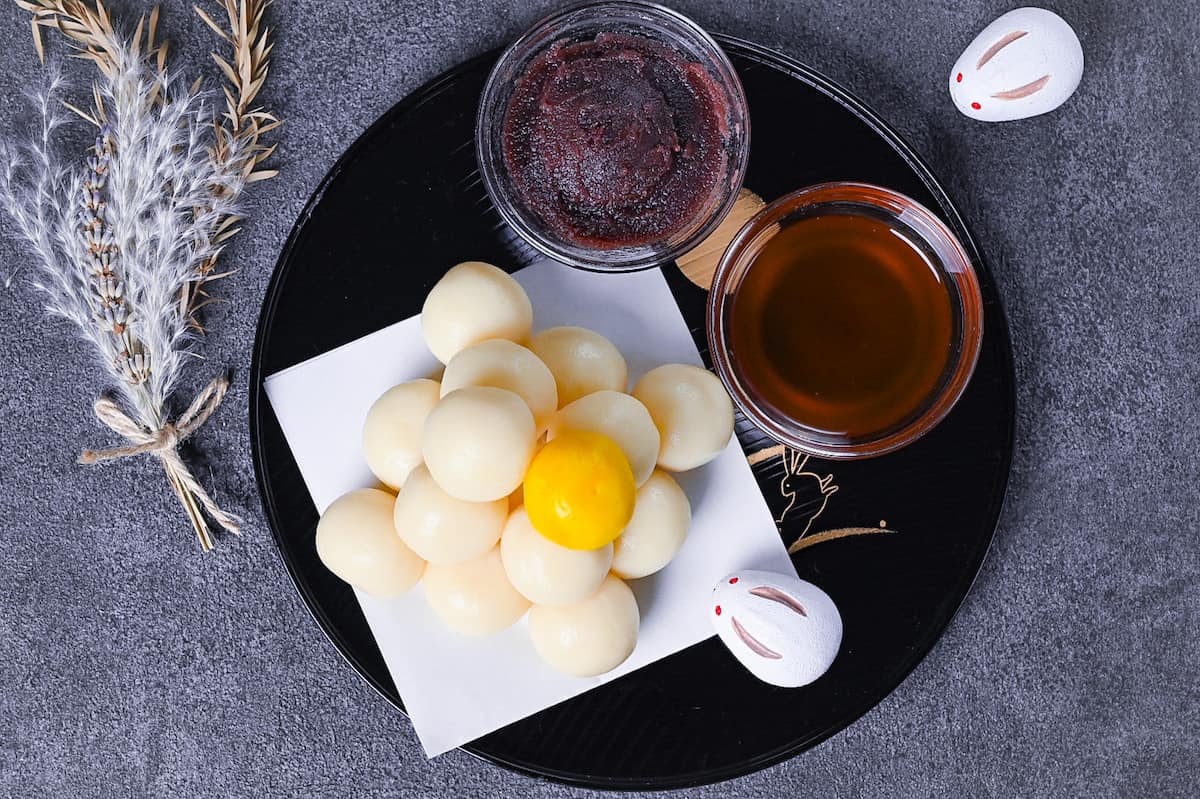
Tsukimi Dango is usually made up of 15 rice dumplings to represent the 15 nights leading up to the day of the festival. Traditionally they are stacked into a pyramid shape and displayed on a decorative plate or on top of a small wooden Shinto offering stand called a “sanbo” (三方). This is then placed in an area with a good view of the moon.
While Tsukimi Dango is generally white, the ones on the top are sometimes coloured yellow and/or green to represent the harvest moon.
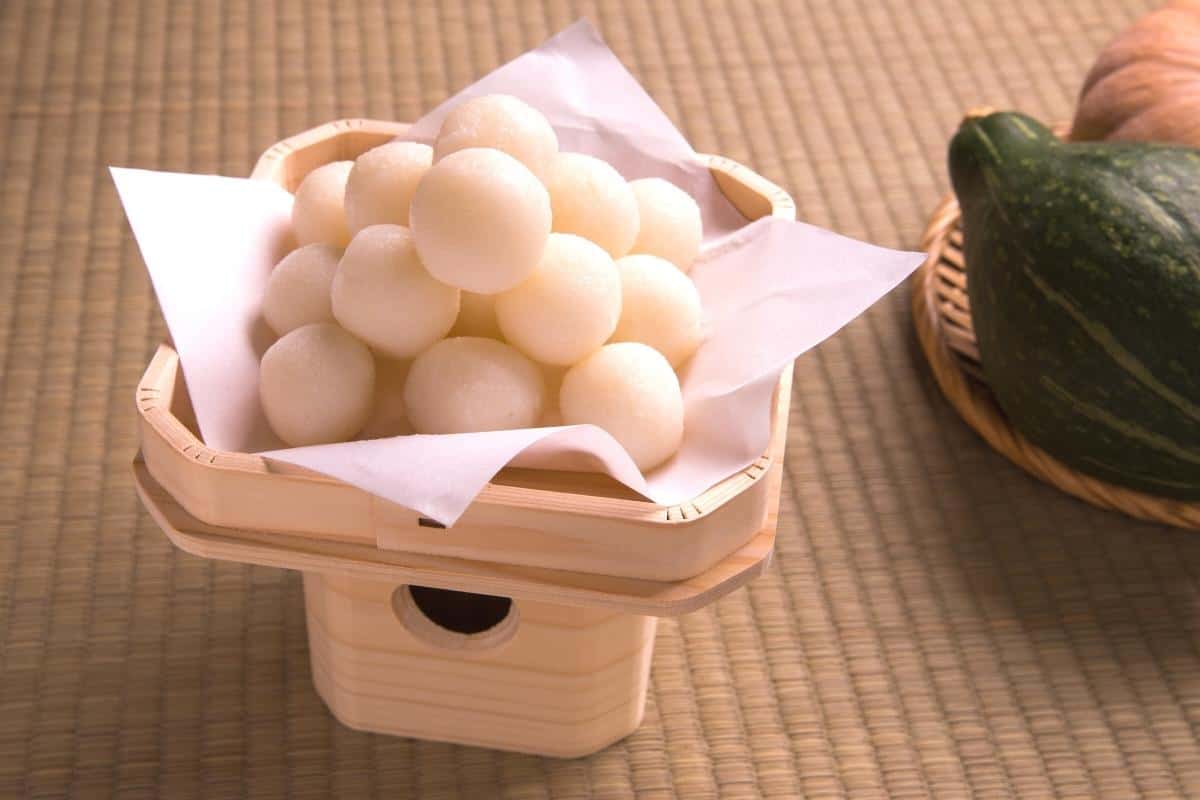
What is Tsukimi?
Tsukimi (月見) is the Japanese version of the mid-autumn festival and the word “Tsukimi” can be translated into English as “moon viewing”. The exact date of the festival has changed throughout history but in modern times its typically held on the 15th day of the 8th lunar month according to the traditional Japanese calendar which was based on the phases of the moon.
Traditionally, the new moon would mark the first day of each month and the 15th coincides with the full moon, this is why it is also known as “Jugoya” (十五夜) or “the 15th night”. It typically falls some time between mid-September to early October on the Gregorian calendar, specifically on the full moon closest to the Autumn equinox.
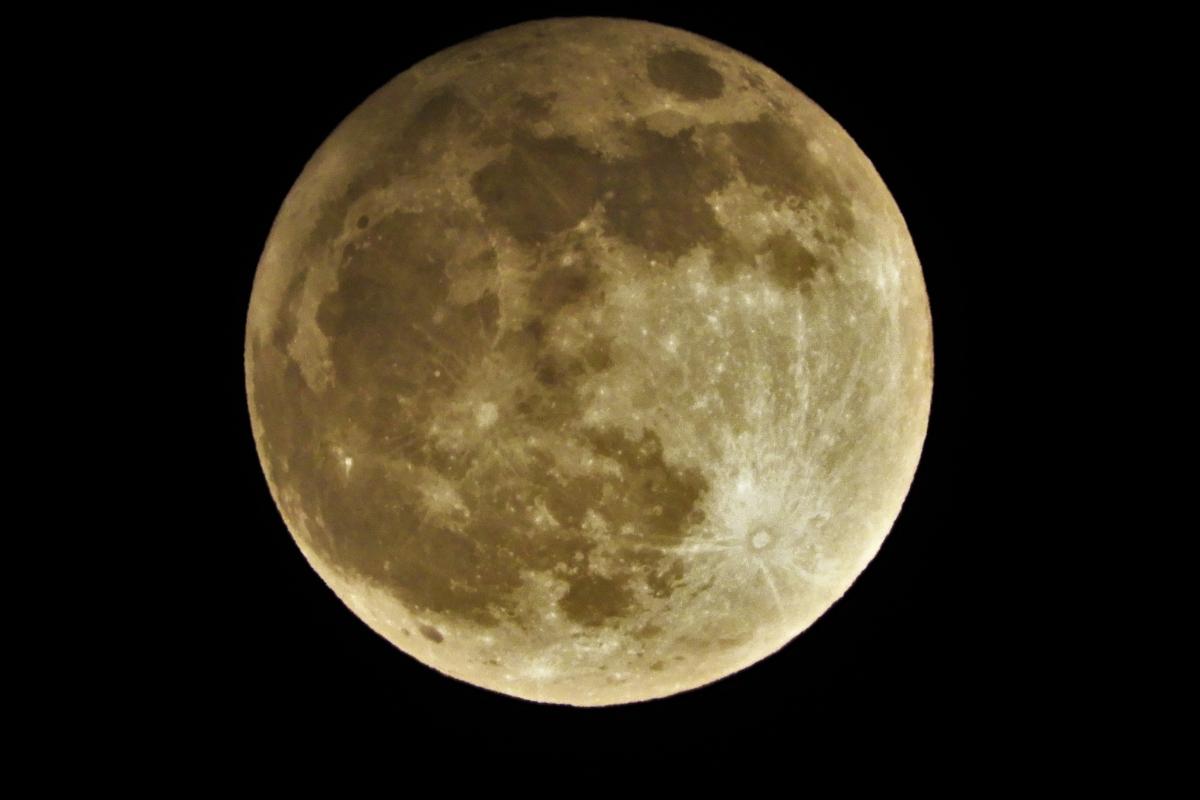
Seasonal produce such as taro, sweet potatoes and chestnuts are displayed as an offering to the moon, praying for a plentiful harvest, and Japanese pampas grass (susuki) is often set next to them to ward off evil spirits. Many shrines and temples hold Tsukimi performances and events which locals can attend.
It is also common to eat “Tsukimi ryori” (dishes made especially for the moon viewing festival) such as Tsukimi udon, Tsukimi dango and Tsukimi soba. There is even a seasonal “Tsukimi burger” that appears at McDonald’s and other fast food chains every September! These dishes usually contain an egg which represents the moon.
The Origin of Tsukimi
The tradition of moon viewing is believed to have been introduced to Japan from China during the Heian period (794-1185AD). The event spread among Japanese nobles who would have boat parties where they would recite poetry and feast while enjoying the reflection of the full moon on the water.
It wasn’t until the Edo period (1603-1868) that the moon viewing festivities spread to the common people. Because the the festival occurred around the time of harvesting crops, it became an event not only to appreciate the beauty of the moon, but a time to show gratitude for an abundant harvest and pray for the following year.
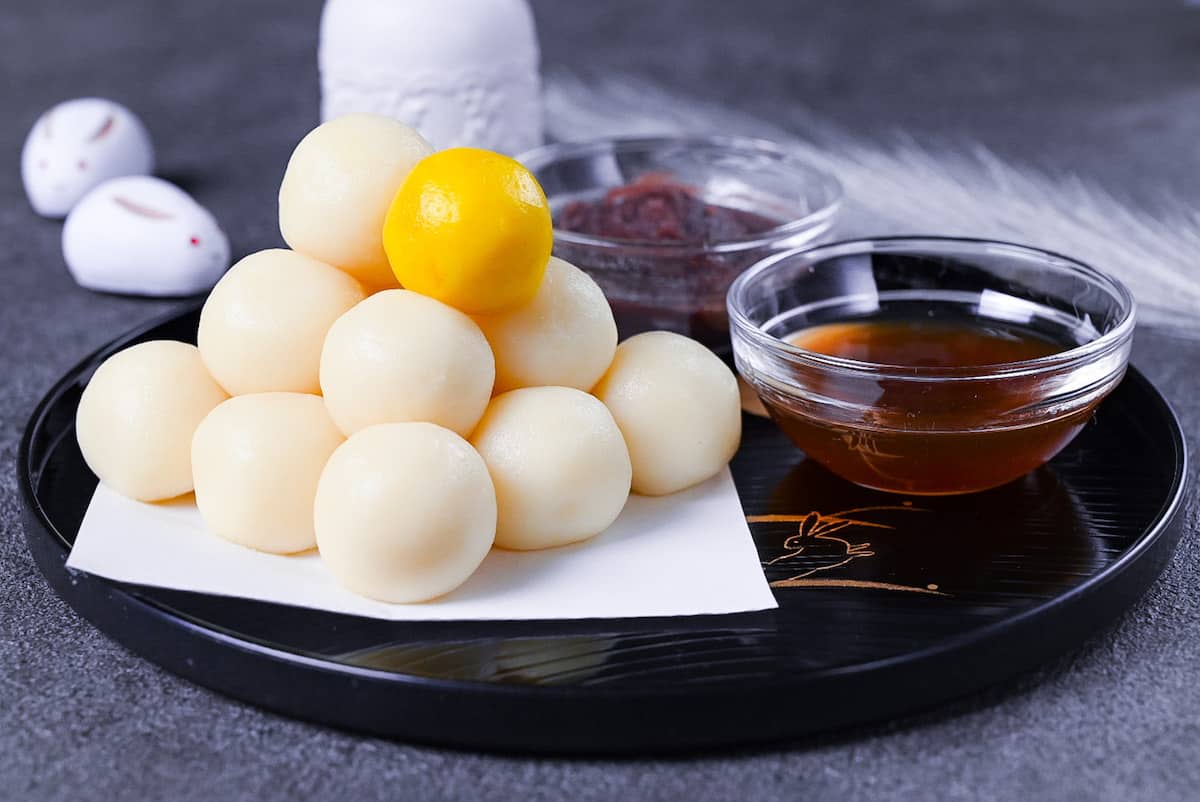
Rabbits on the Moon
While the mid-Autumn festival originated from China, Tsukimi involves many aspects of Japanese traditions and culture. One tradition that has carried on to this day is the idea of rabbits pounding rice cakes on the moon, which originates from an ancient story that comes from Buddhism and Japanese folklore.
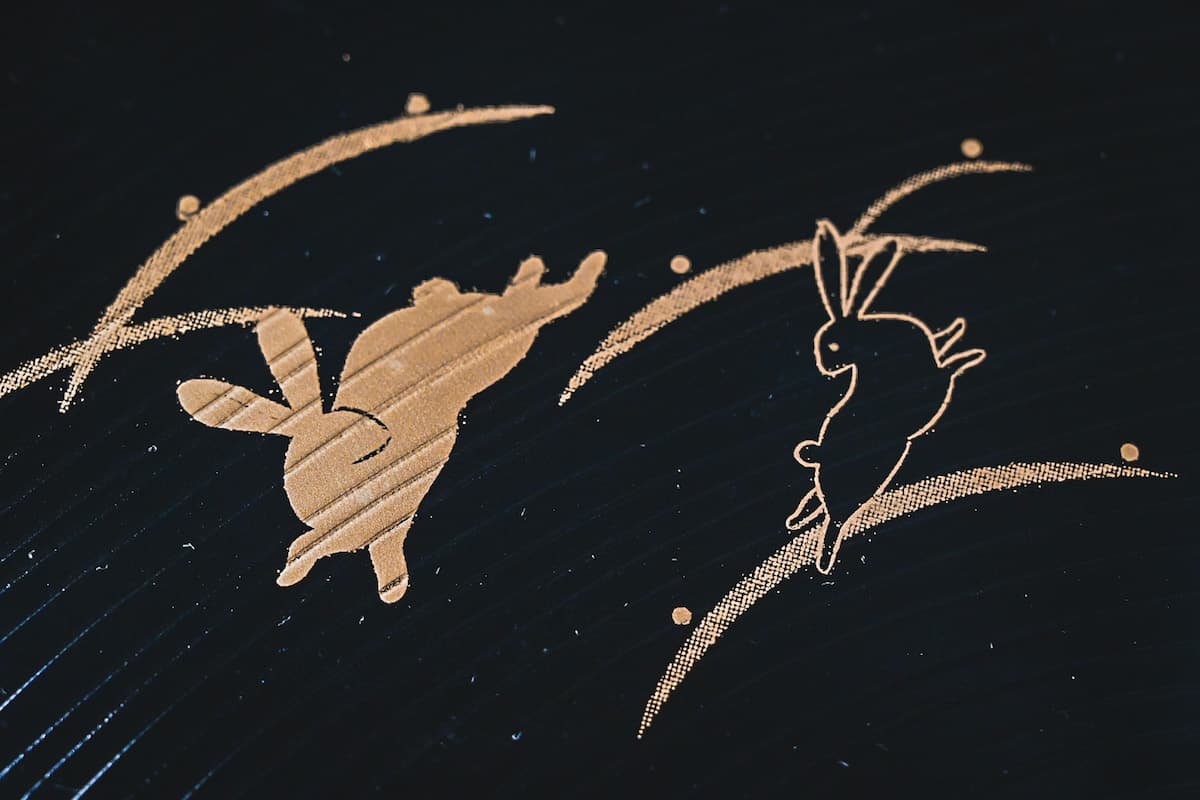
The story starts with a monkey, fox and rabbit, who were sitting around a fire when they were approached by a frail old man who was begging for food. The monkey gathered fruits and the fox caught fish, however the rabbit couldn’t find anything to offer and threw himself onto the fire, giving himself as an offering. The beggar turned out to be a God called “Taishakuten”. Taishakuten was moved by the rabbit’s kindness, so he brought him back to life and sent him to live on the moon. Many Japanese people say that the shadow on the moon is shaped like a rabbit pounding rice cakes.
Because of this, rabbits are often decorated on moon related items and associated with the Tsukimi festival!
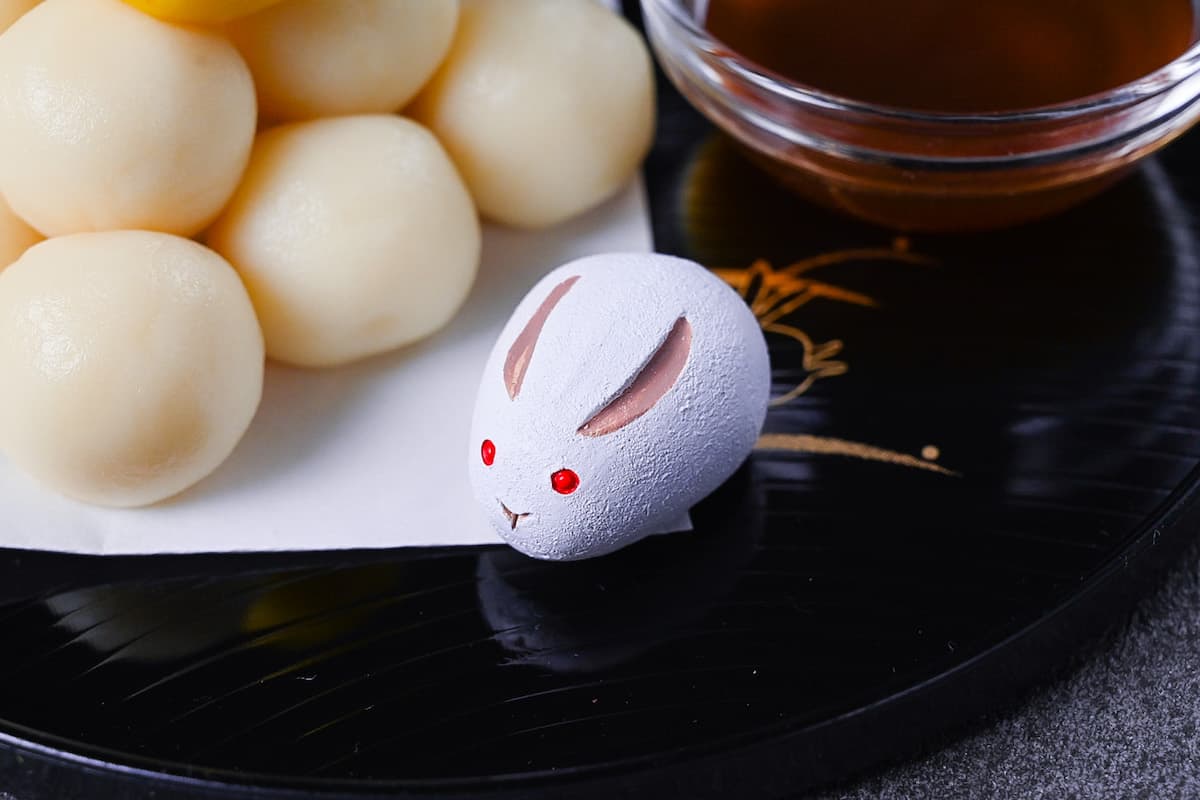
Ingredients & Substitution Ideas
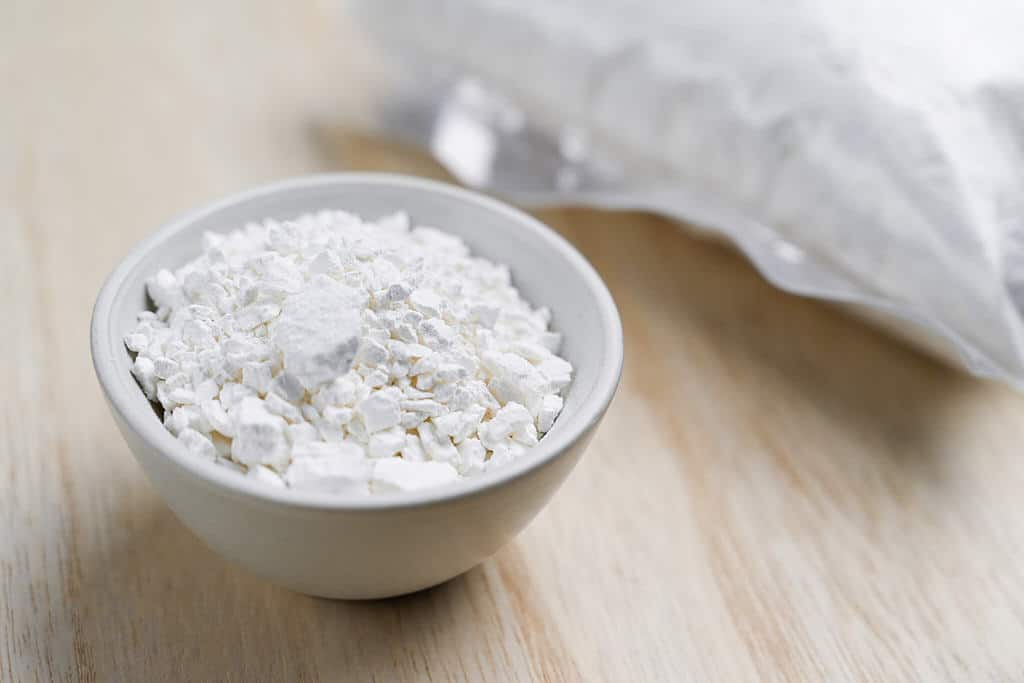
To make this Tsukimi Dango recipe, all you need is three ingredients:
- Glutinous Rice Flour: To achieve that chewy dango texture, it is essential to use glutinous rice flour made from mochikome (mochi rice) and not regular rice flour. The best option is shiratamako (a coarse glutinous rice flour used to make shiratama dango), but mochiko is more affordable and works well too. In English, it is sometimes called “sweet rice flour”.
- Silken Tofu: For a softer texture, I love to use silken tofu instead of water. Just make sure it’s silken or soft tofu since firm tofu doesn’t contain enough moisture to make a smooth dough.
- Turmeric: An optional ingredient to make the yellow dango on top. Only a small amount is used so it doesn’t taste of turmeric. If you prefer, you could use yellow food coloring instead.
Tsukimi dango are plain and unsweetened so I recommend eating them with either of the following:
- Mitarashi sauce: A sweet soy sauce glaze, I’ve included how to make it in the recipe card at the bottom of the page.
- Koshian: Smooth red bean paste.
- Tsubuan: Chunky red bean paste (check out my tsubuan recipe here).
Curious about the exact brands and products that bring my recipes to life? Discover the brands and ingredients behind my recipes at the Sudachi Amazon Storefront. Explore my handpicked pantry essentials and find your next kitchen favorites!
Jump to Full Recipe Measurements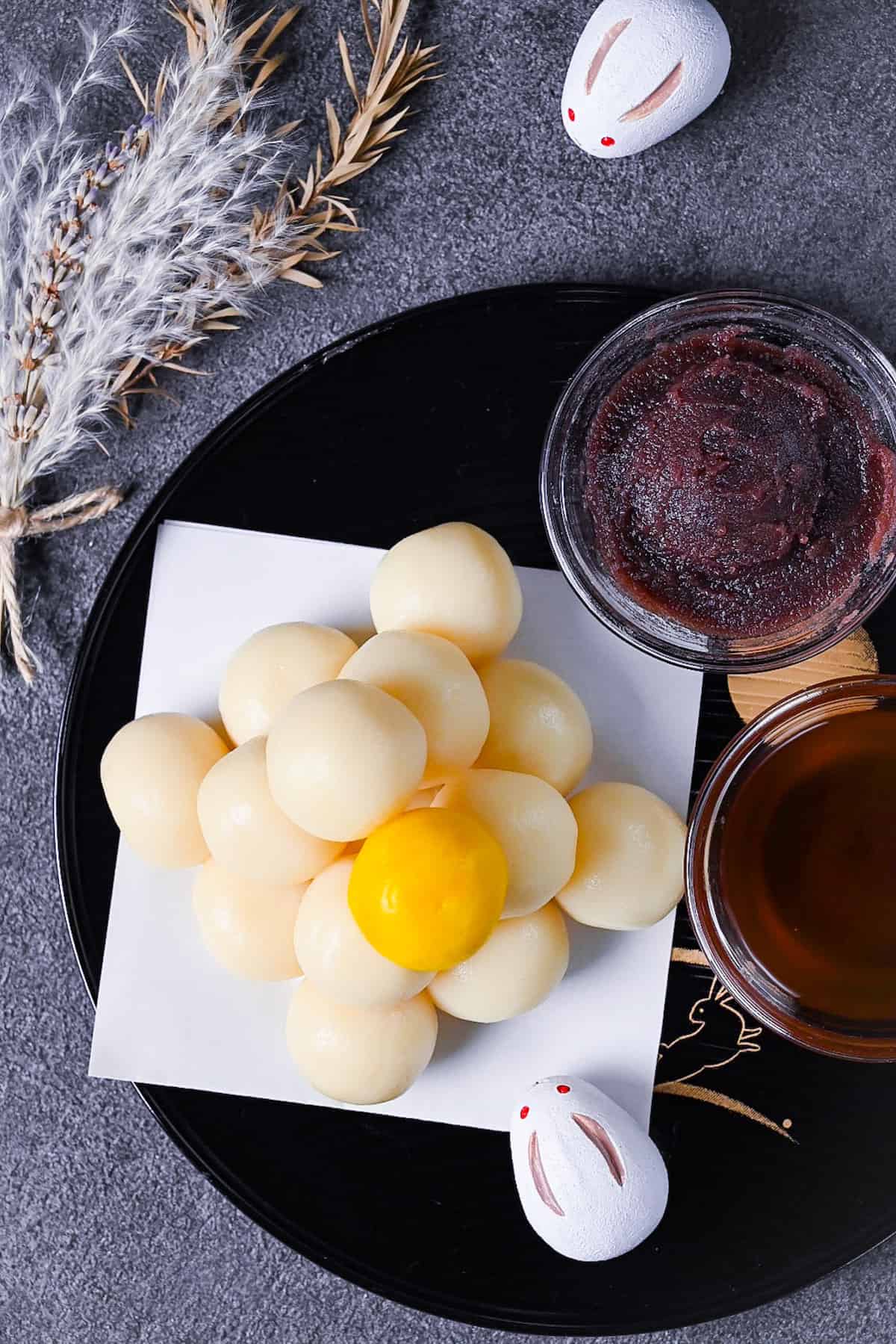
Visual Walkthrough & Tips
Here are my step-by-step instructions for how to make Tsukimi Dango at home. For ingredient quantities and simplified instructions, scroll down for the Printable Recipe Card below.
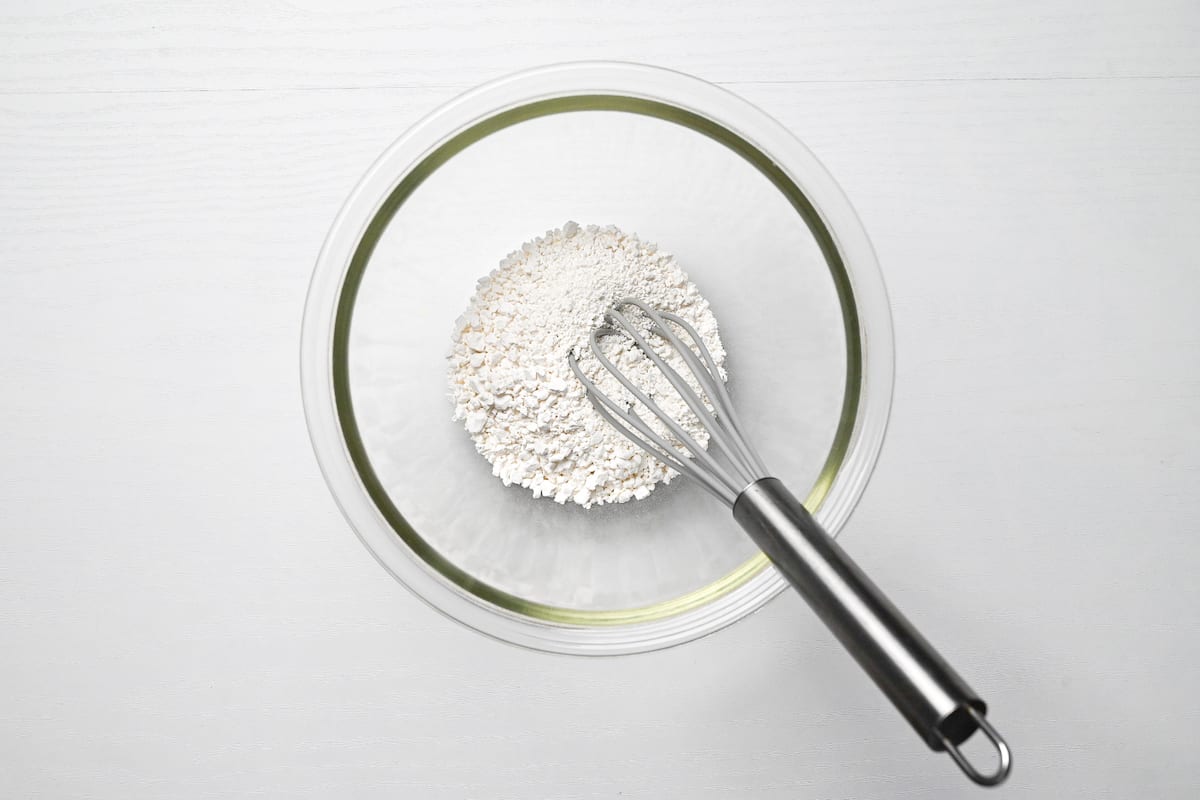
Because shiratamako is made of coarse granules, it can’t be sifted. Instead, I whisk it while it’s dry for 1 minute. It helps break up any large lumps and adds a bit of air which makes it easier to incorporate into the tofu, yielding a smoother result. If you’re using mochiko you can use a sifter to ensure they aren’t any lumps.
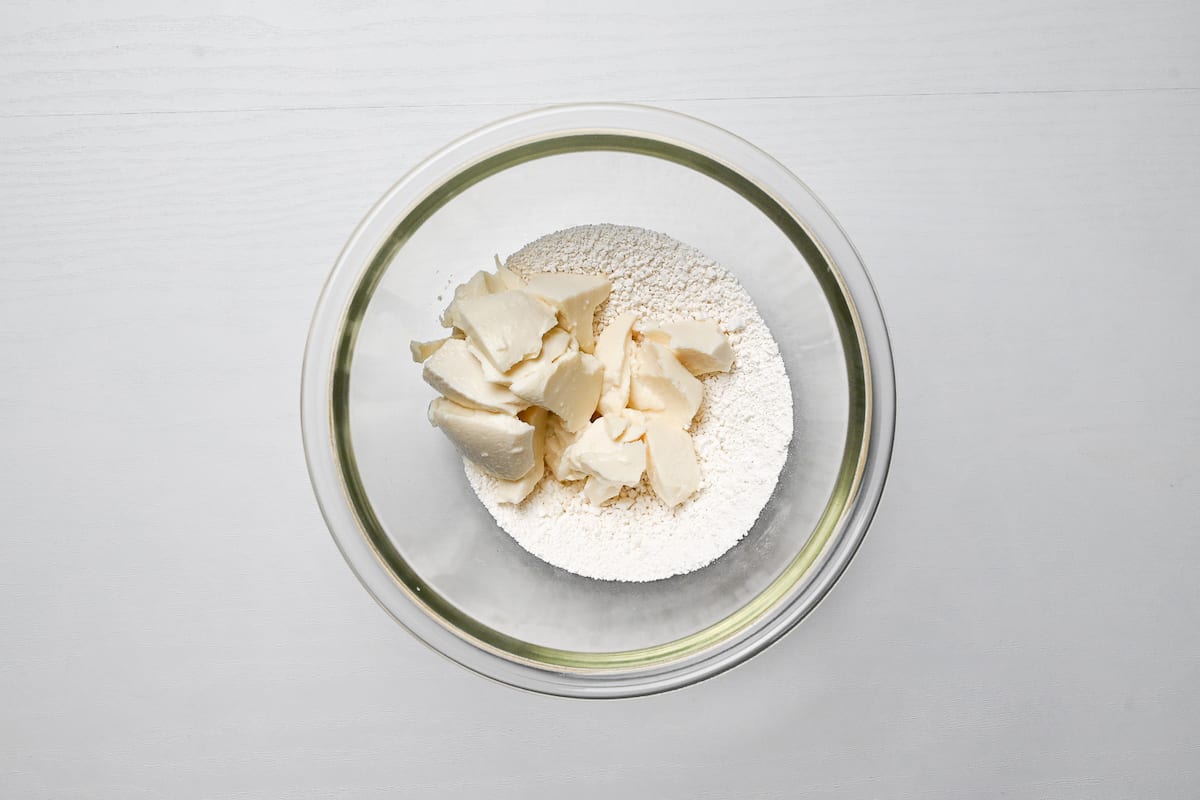
Knead the silken tofu into the glutinous rice flour by hand, not only will it help the ingredients mix together more thoroughly, but you will also have a better idea of when it’s complete.
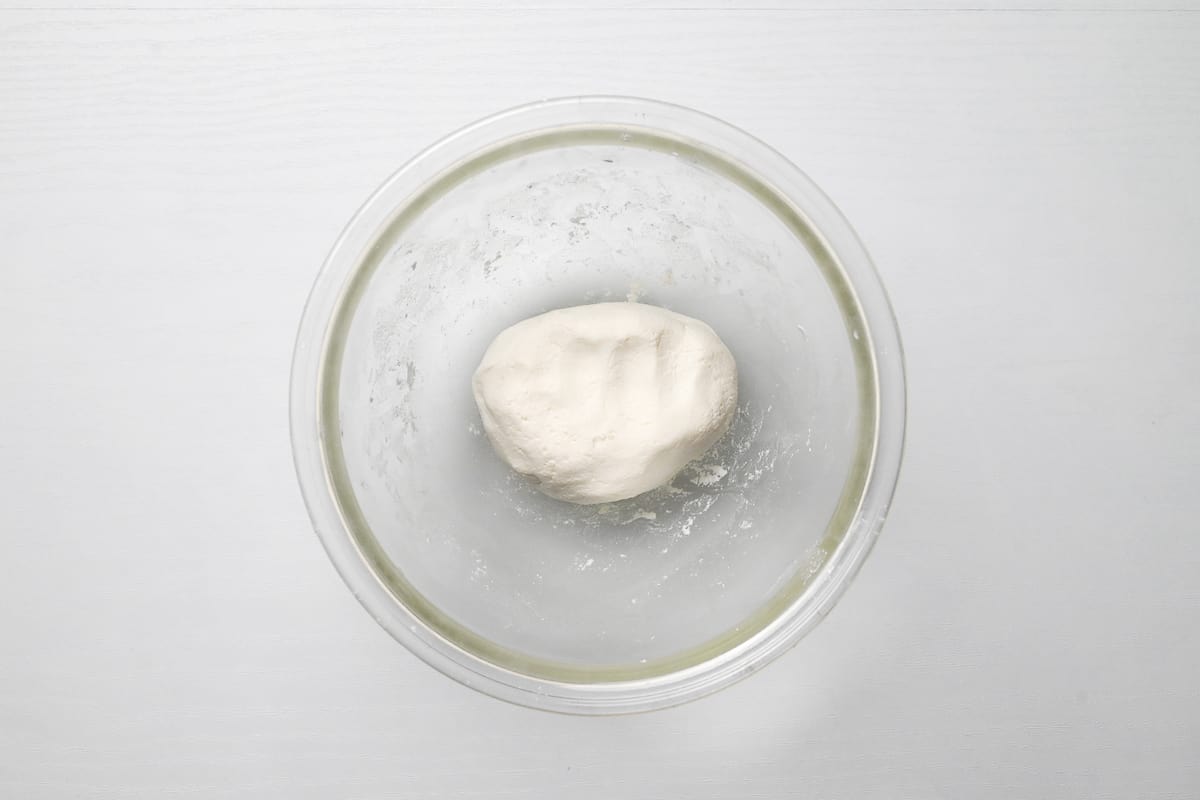
I aim for a play dough-like texture, there shouldn’t be any cracks but it also shouldn’t be a wet dough.
Add the tofu gradually to avoid making the mixture too wet. If you find the mixture is a bit too dry, add silken tofu (or water) 1/2 a tsp at a time and keep kneading until it forms a smooth ball. In Japanese there is a saying that the texture should feel like an earlobe.
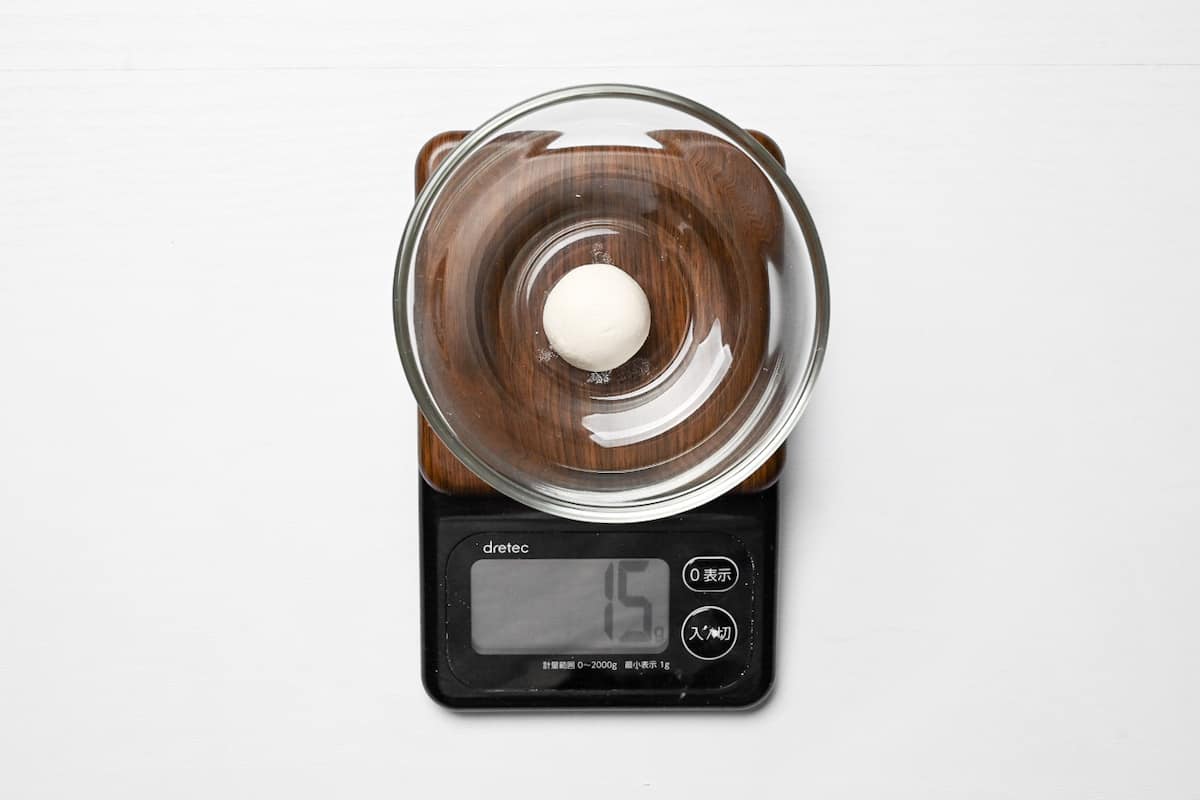
To make all the dango uniform, I measure out each ball using a digital scale. Each ball should be approximately 15g.
Roll them in the palm of your hand and place them on a plate until it’s time to cook.
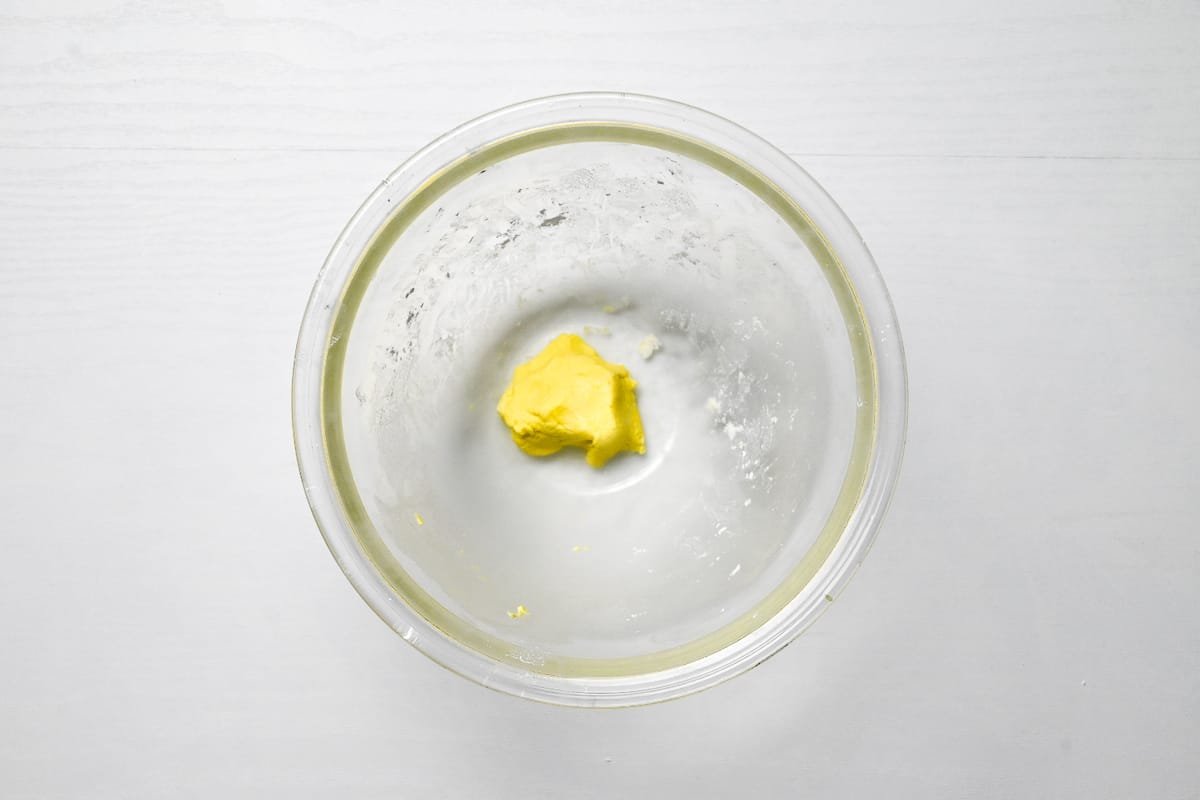
Knead the last piece with a pinch of turmeric or a drop of yellow food coloring until evenly colored.
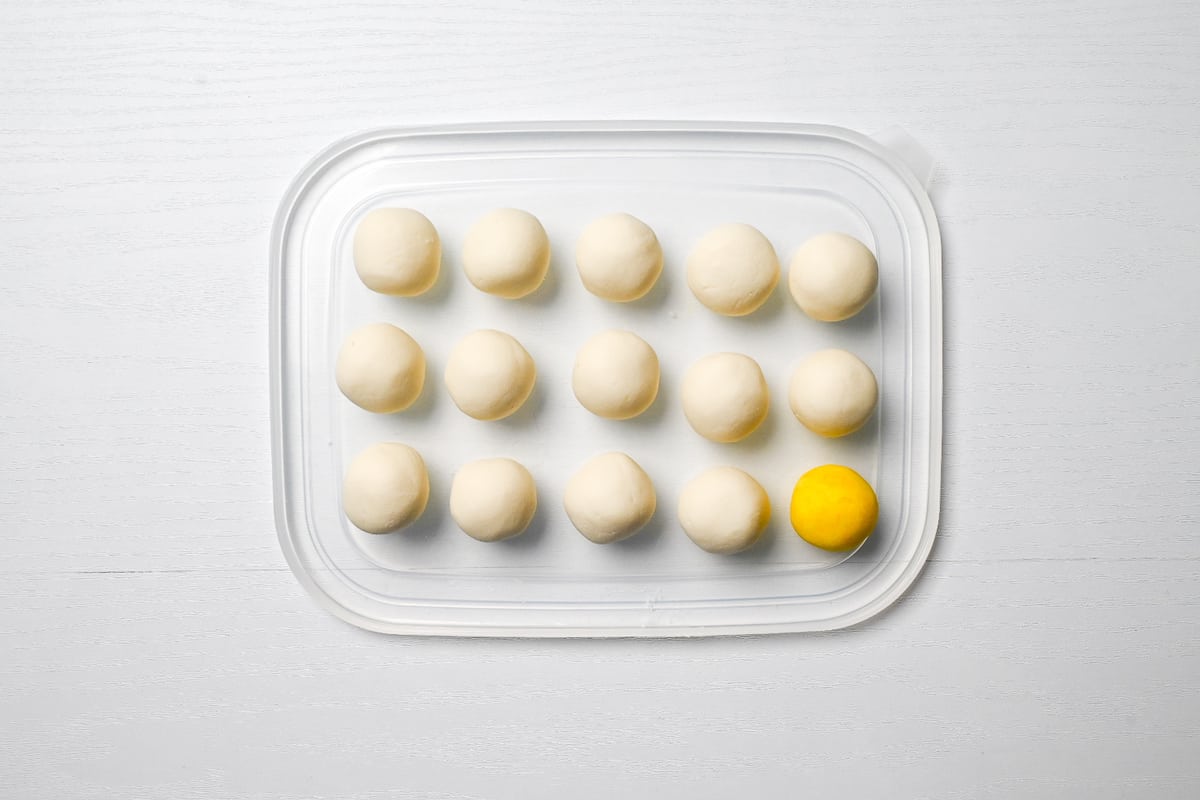
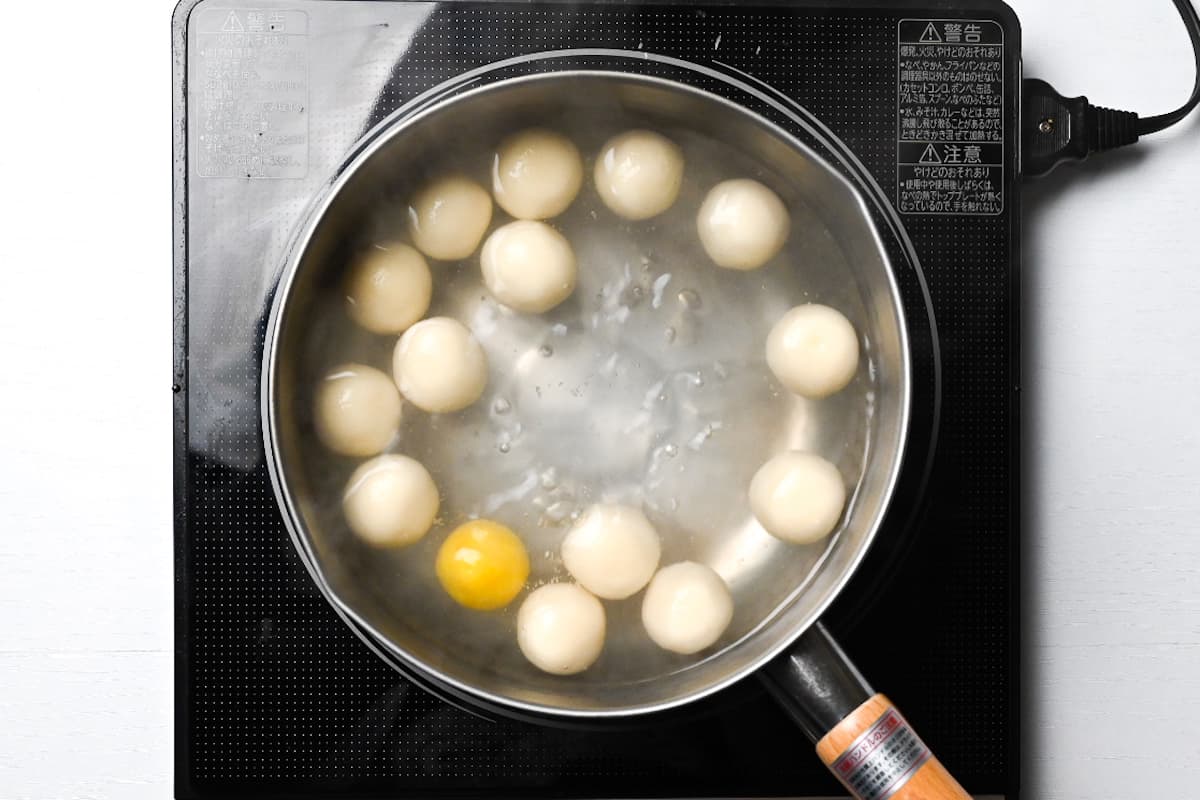
Bring a pot of water to a rolling boil and carefully place the dango in so that they don’t lose their shape. Be sure to stir them from time to time to stop them from sticking to the bottom of the pan.
Allow them to boil until they start to float (about 5-7 minutes). Once they start floating, set a timer for two minutes and prepare a bowl of ice water.
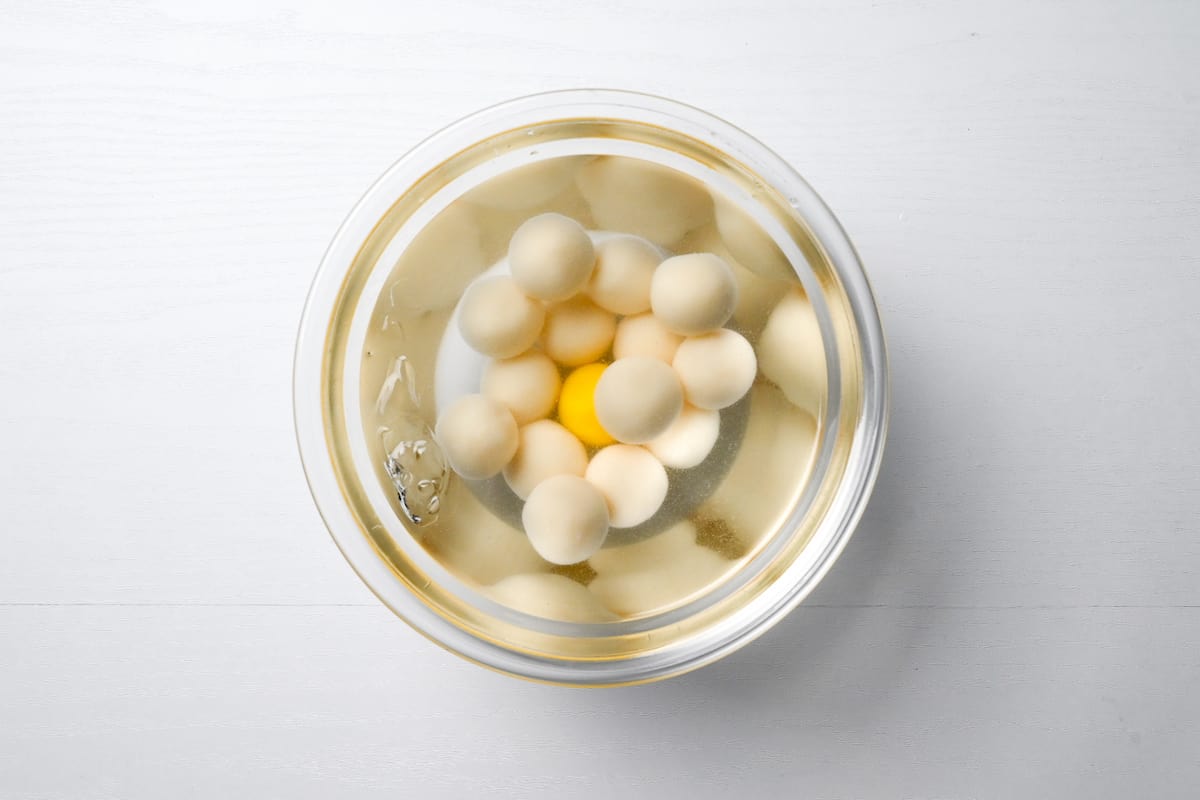
Once the dango are cooked, transfer them to the ice water to stop the cooking process and cool them down.
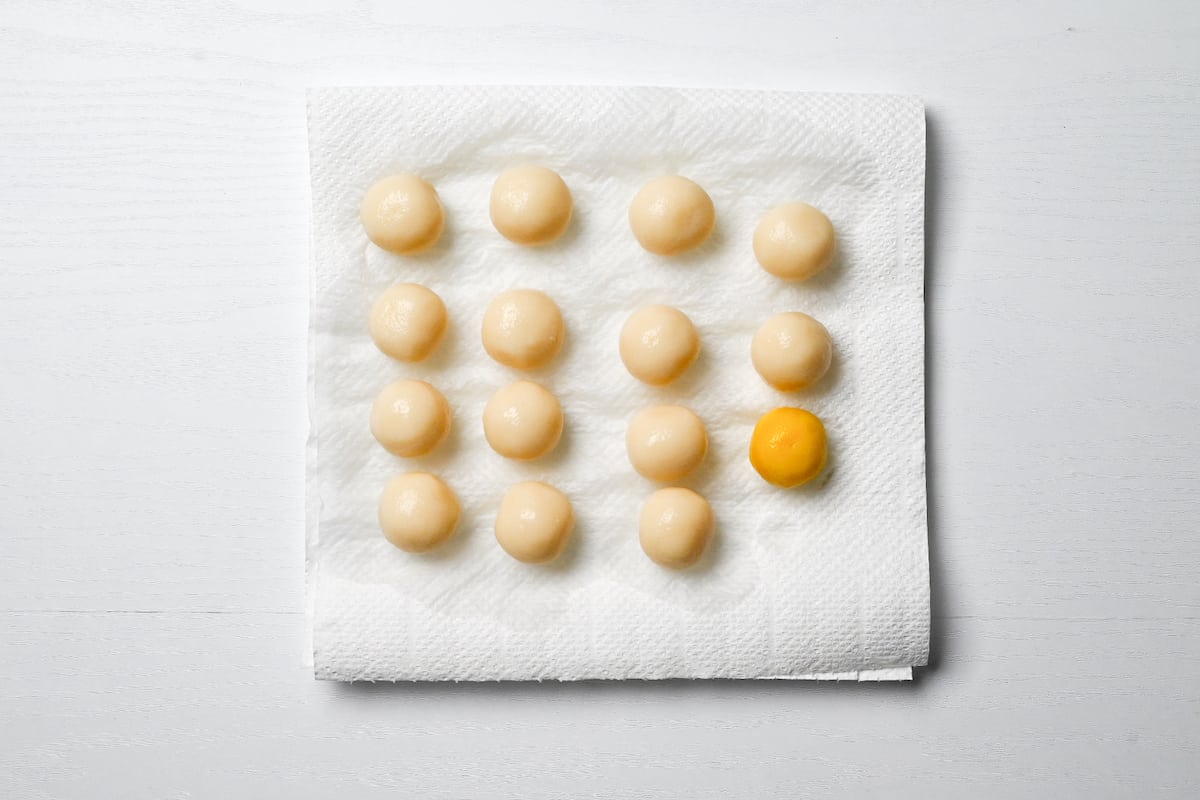
Once cool, I recommend placing the dango on a piece of kitchen paper and allowing them to air dry a little. If you try to stack them while they are still wet, they will slide and the pyramid of dango will fall down.
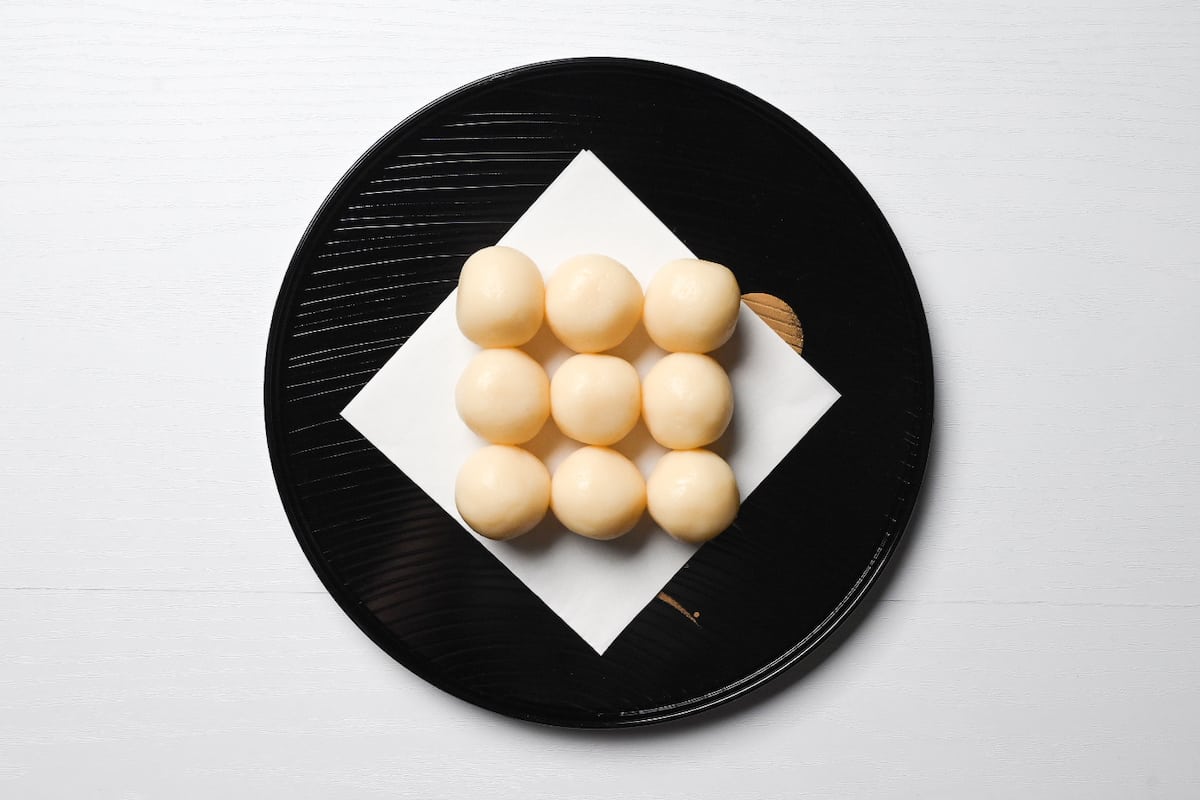
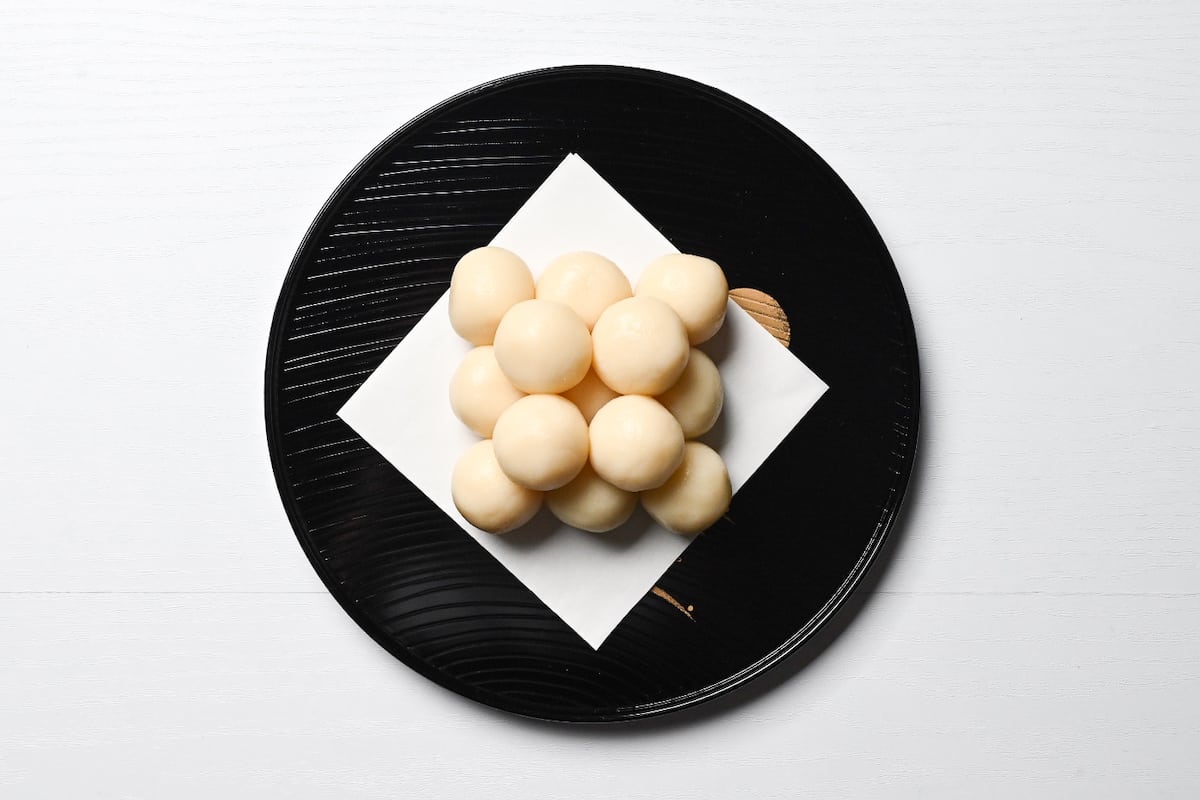
Once they’ve dried enough, arrange the dango so that there are 9 at the base (3×3) and 4 in the middle (2×2). These layers should be all white.
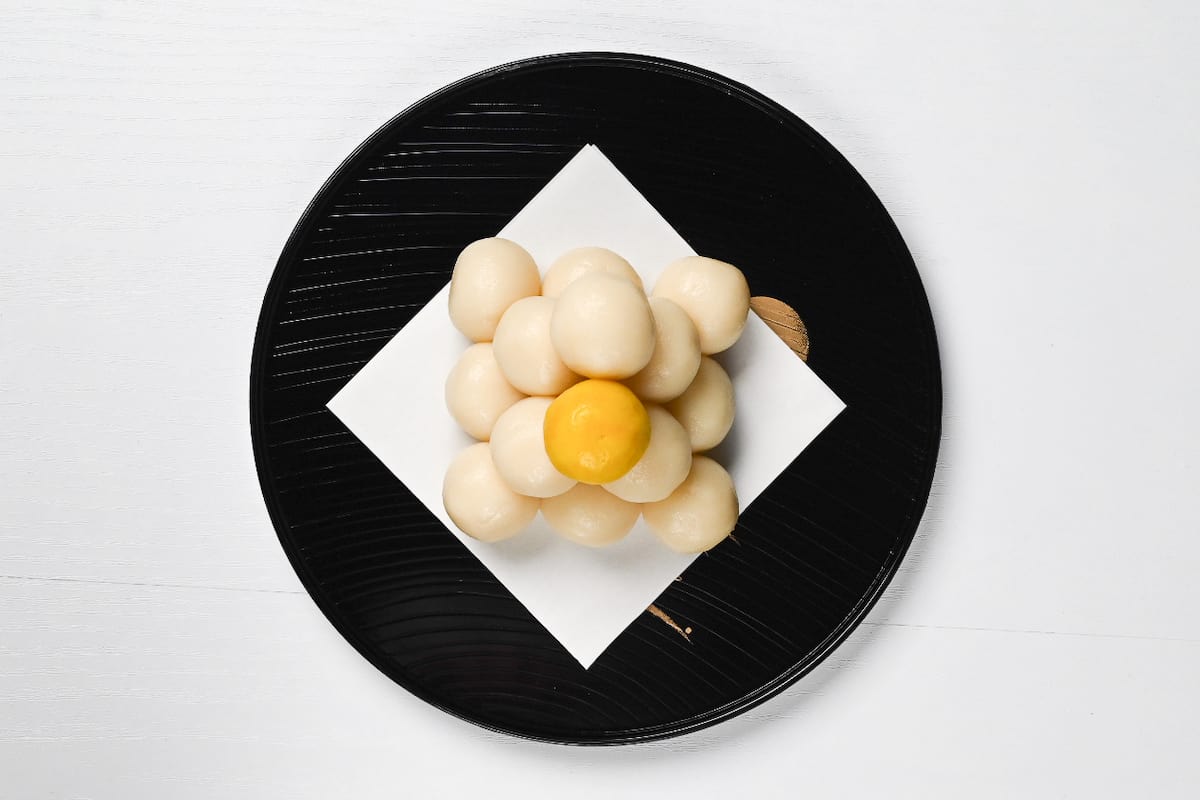
Place one white and one yellow on the top to complete the pyramid.
How to Store
Tsukimi dango are best eaten on the day that they’re made, however if you want to make them in advance they freeze well. You can freeze them for up to one month in an airtight freezable container or ziplock bag, simply defrost at room temperature for 30 mins to 1 hour before eating.
Storage summary
Room temperature – 6 hours.
Refrigerated – Not recommended.
Frozen – Up to 1 month.
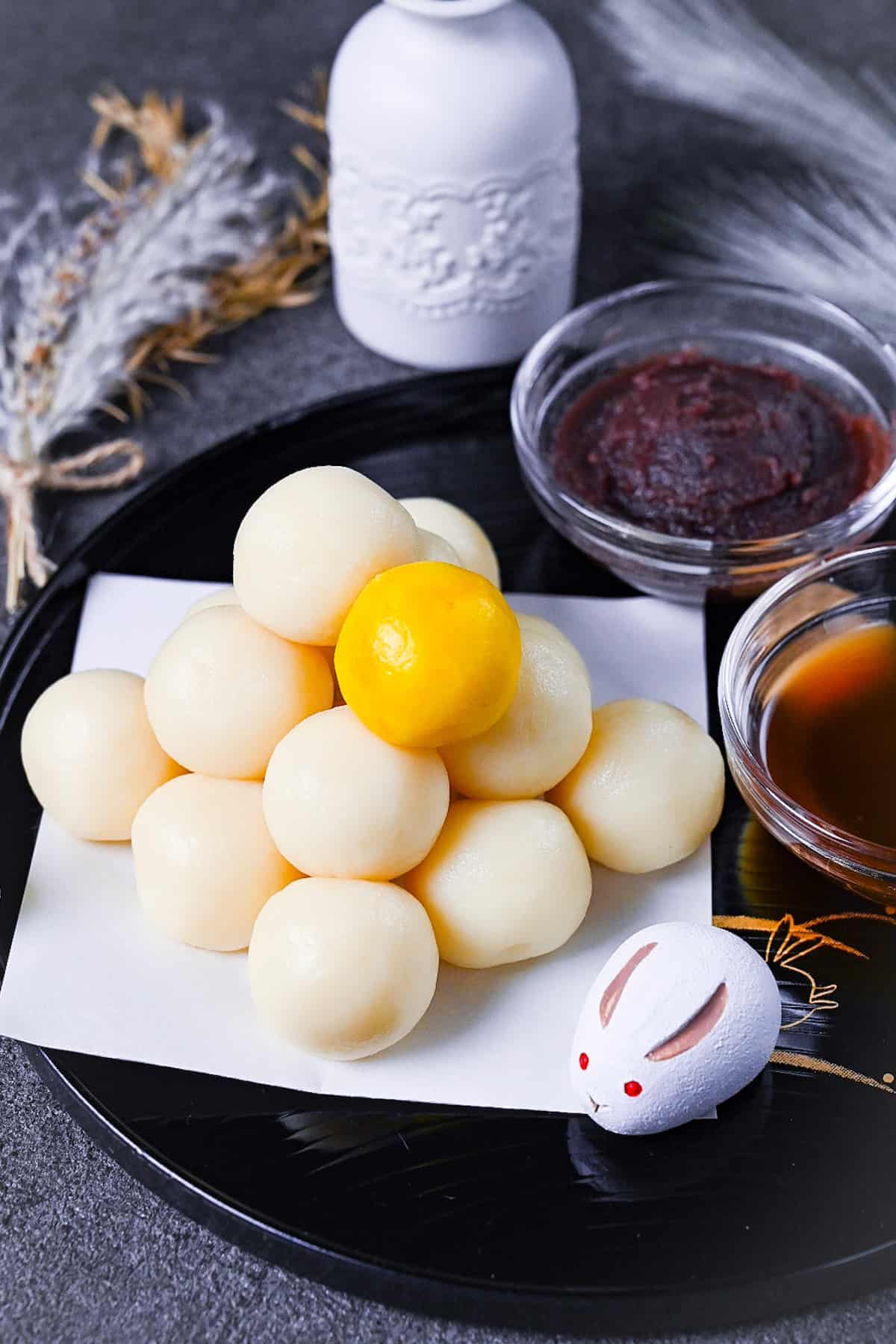
FAQ
Dango is a traditional Japanese sweet rice dumpling made with glutinous rice flour.
It’s usually made of a mixture of Japanese rice flour (joshinko), glutinous rice flour (mochiko or shiratamako) and water. However in my recipe I replace the water with silken tofu.
Tsukimi is the Japanese moon viewing festival held some time between mid-Sptember and early October.
Traditionally people would make displays of seasonal produce, pampas grass and Tsukimi Dango in a place with a good view of the moon. These days most people simply celebrate by eating Tsukimi Ryori (moon viewing dishes) such as dango, Tsukimi udon or McDonald’s Tsukimi burger. Some shrines and temples hold events and performances too.
Tsukimi dishes usually represent the moon in some way. The tsukimi dango is the most iconic, but dishes with egg are also popular in things like Tsukimi udon, Tsukimi soba and Tsukimi burger (just to name a few).
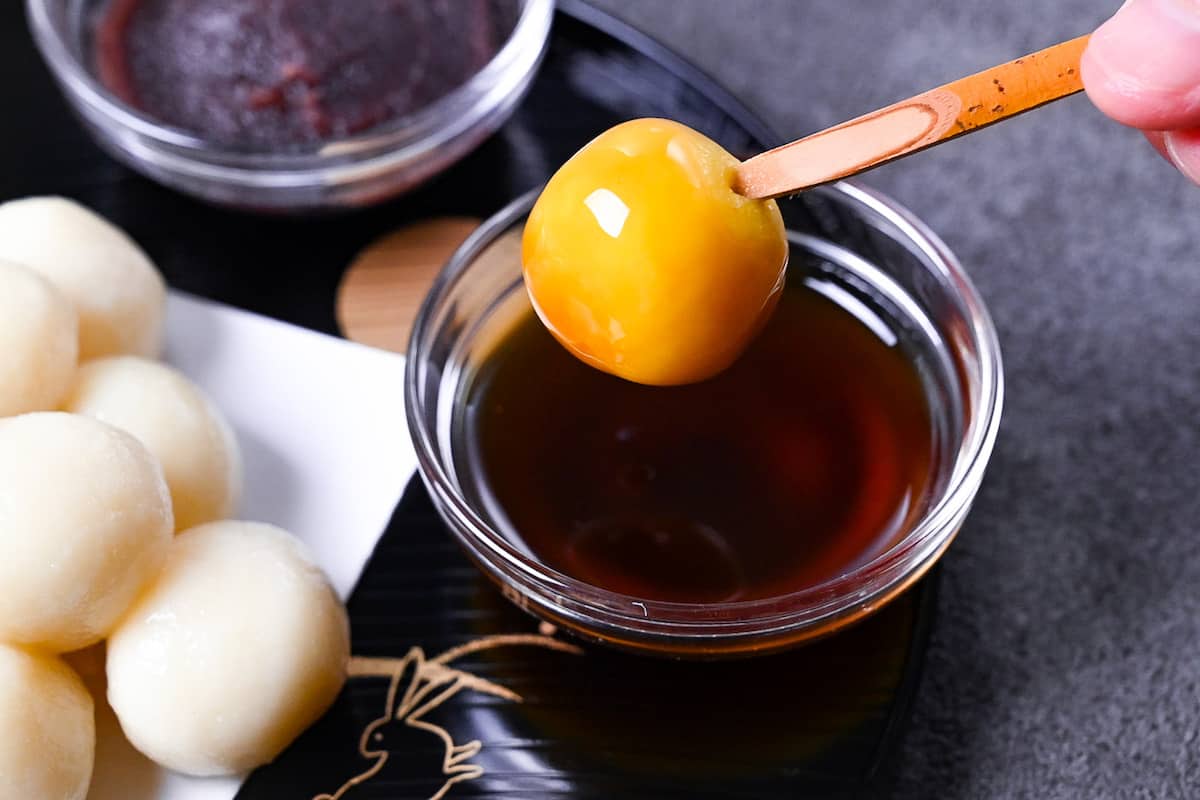
I hope you enjoy this Tsukimi Dango recipe! If you try it out, I’d really appreciate it if you could spare a moment to let me know what you thought by giving a review and star rating in the comments below. It’s also helpful to share any adjustments you made to the recipe with our other readers. Thank you!
More Moon Gazing Recipes
Enjoy some of these recipes during the moon gazing festival!
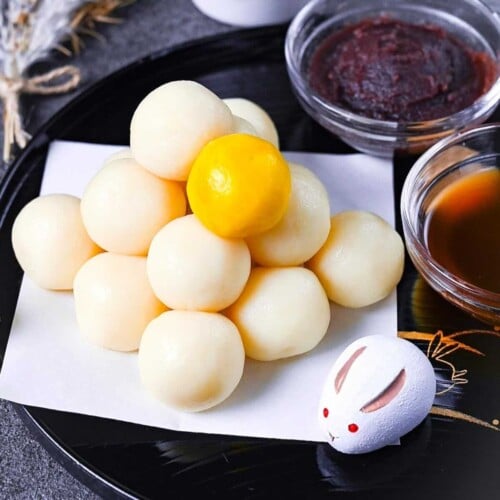
Tsukimi Dango (Moon Gazing Dumplings)
Ingredients
Tsukimi Dango
- 100 g glutinous rice flour shiratamako or mochiko
- 125 g silken tofu + 5g if the mixture is too dry
- 1 pinch turmeric or yellow food colouring
- mitarashi sauce recipe below or smooth red bean paste (optional)
Instructions
- Bring a pot of water to a rolling boil over medium heat. While you wait, whisk the 100 g glutinous rice flour in a bowl. (If you use mochiko you can sift it instead.)

- Add 125 g silken tofu to the bowl and knead it with your hands.

- Knead until it reaches a play dough texture. It should be smooth with no cracks. If it feels a little dry, add more silken tofu 1 tsp at a time. (If you don’t have any more tofu then add 1/2 tsp water at a time instead.)

- Measure out 14 balls, approx 14-15g each.

- Optional step: Add 1 pinch turmeric or yellow food colouring to the last piece of dough and knead until the color is even.

- You should have 15 balls in total.

- Gently add the dango to the pot of boiling water and stir from time to time to stop them from sticking to the bottom.

- Once they start to float (approx 5-7 minutes later) set a timer for 2 minutes. During these two minutes, prepare a bowl of ice cold water.

- After 2 minutes of floating, transfer the dango to a bowl of ice cold water and leave to cool for 5 minutes.

- Line a plate with kitchen paper and place the dango on the paper, leave them to air dry for about 30 minutes.

- Make the base of the pyramid by lining up 9 balls in a 3×3 formation.

- For the next layer, add 4 balls in a 2×2 formation.

- The top layer has two. If you make a yellow one, it should be on the top at the front of the display.

Mitarashi sauce (optional)
- Mix the 1 tbsp caster sugar, ½ tbsp mirin, ½ tbsp soy sauce, ½ tsp cornstarch and 1 ½ tbsp cold water in a small saucepan. Place the saucepan on the stove and heat on low. Stir continuously until thick and glossy.

- Serve and enjoy!

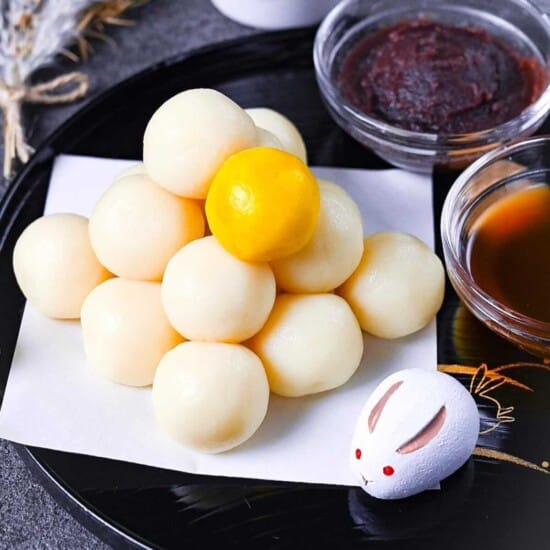


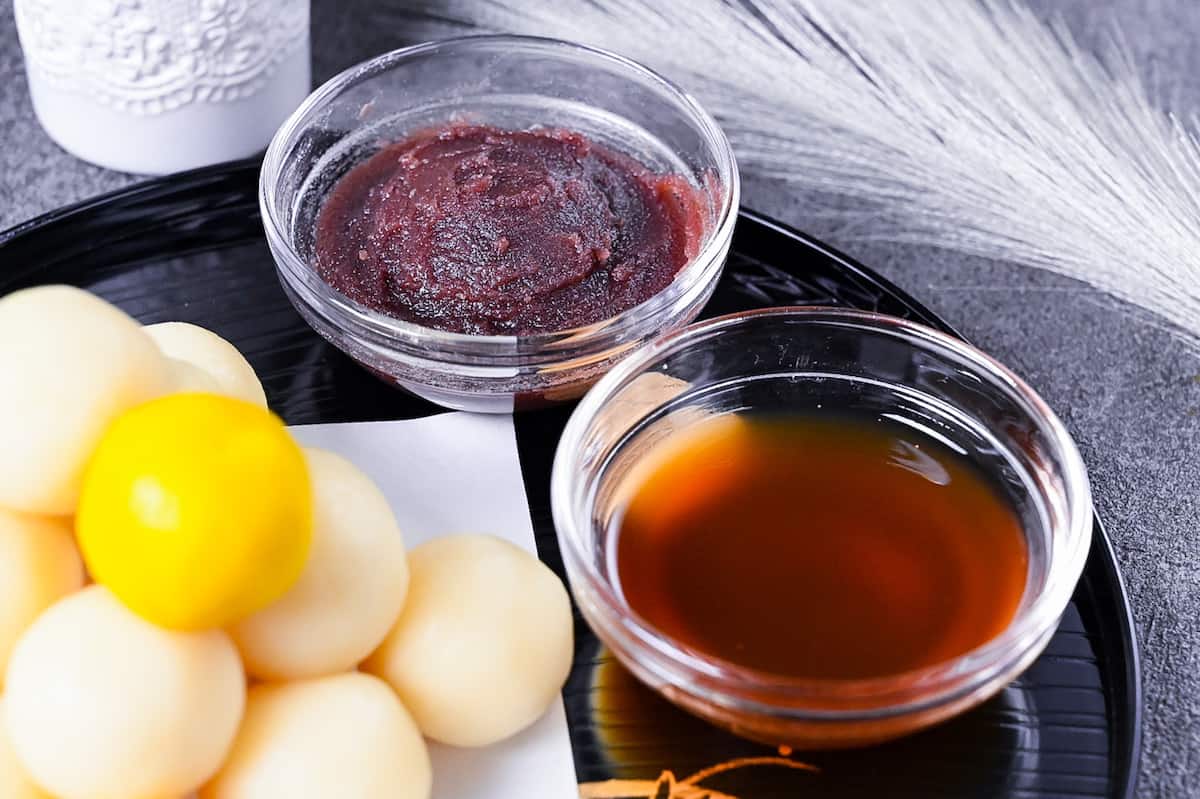
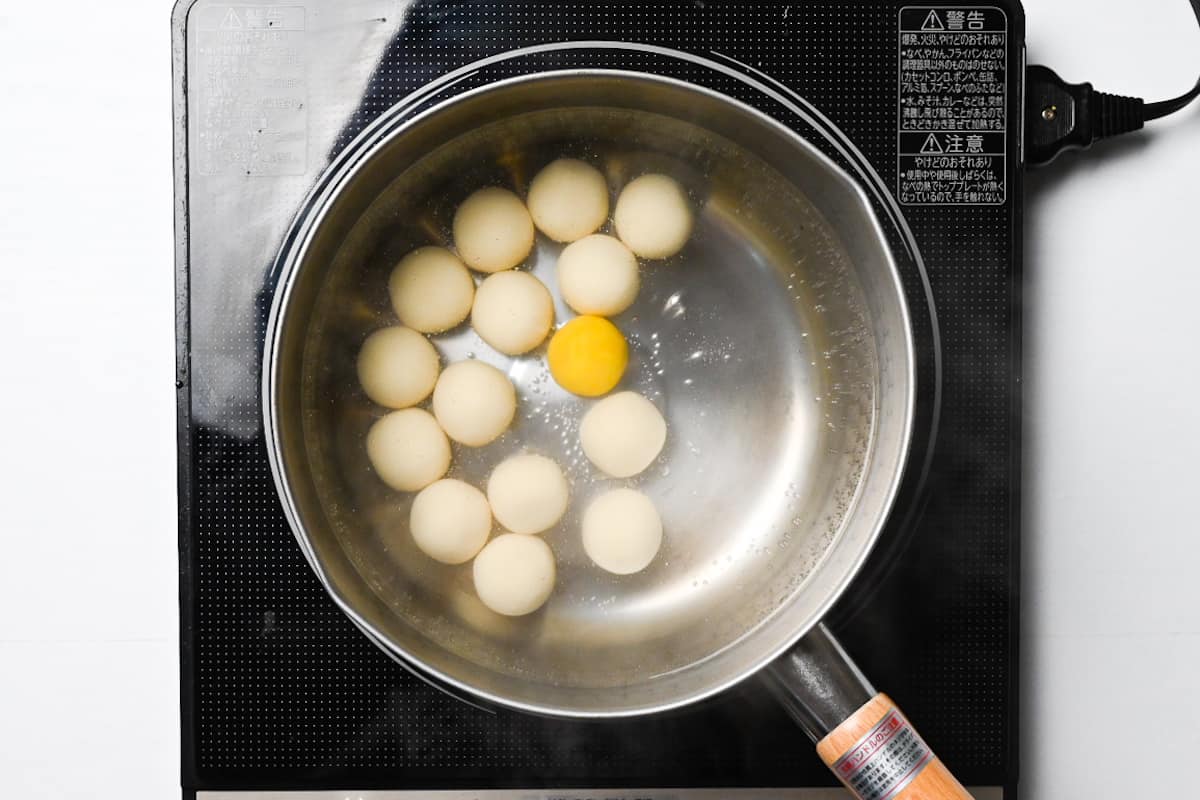
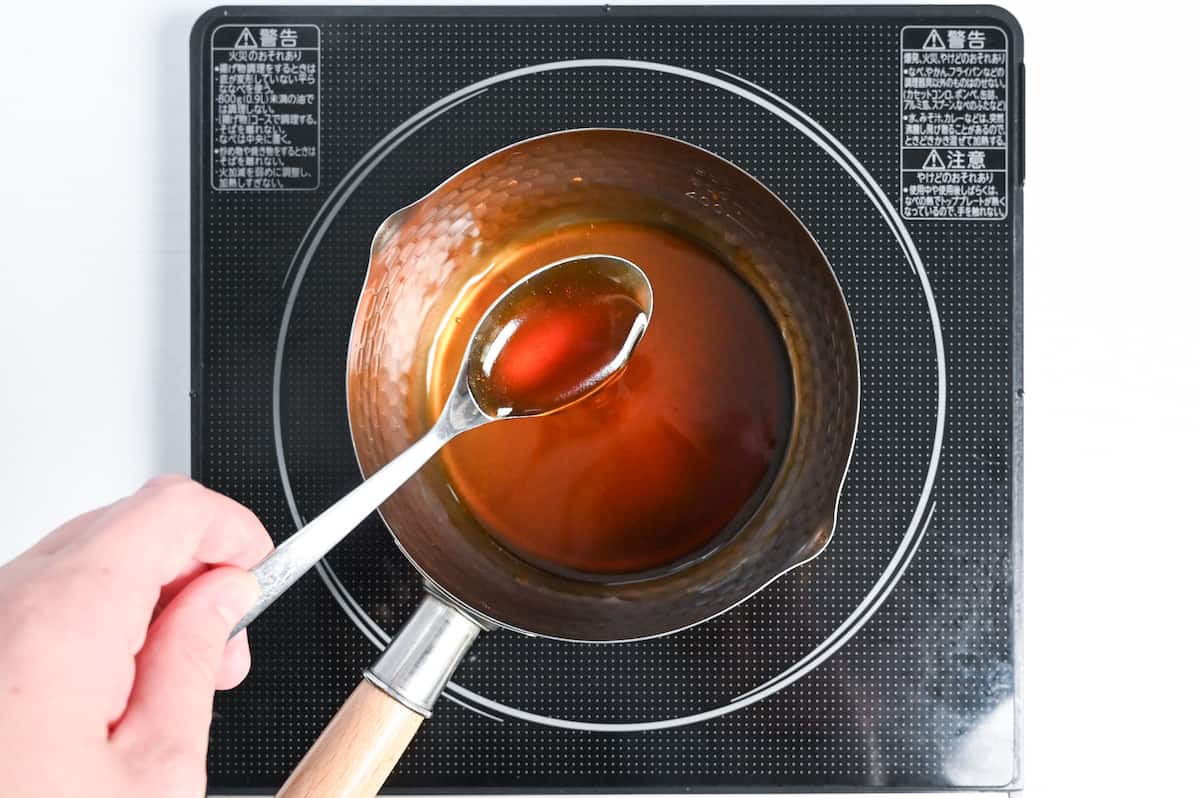
Leave a rating and a comment